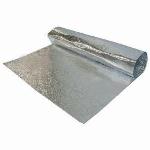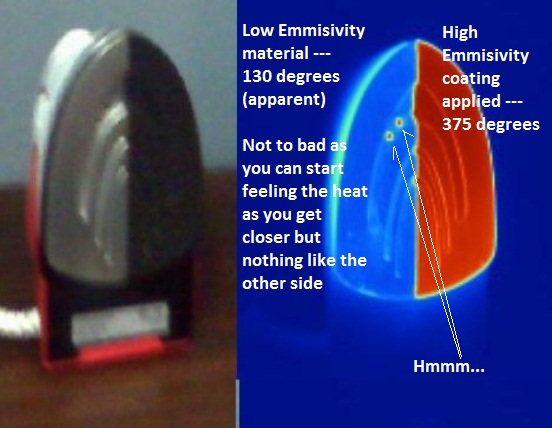 A Radiant Barrier (RB) is a product designed to only block radiant heat transfer from happening and is rated based on its reflectivity & emissivity values per ASTM C 1313. In order to qualify as a Radiant Barrier it must have a reflectivity rating of .9 or more (the higher the better). A radiant barrier DOES NOT have an R-Value (though bubble faced styles may claim the air pocket as an R 1), nor does it improve another materials performance or R-Value though it can reduce the amount of heat said material has to deal with.
A Radiant Barrier (RB) is a product designed to only block radiant heat transfer from happening and is rated based on its reflectivity & emissivity values per ASTM C 1313. In order to qualify as a Radiant Barrier it must have a reflectivity rating of .9 or more (the higher the better). A radiant barrier DOES NOT have an R-Value (though bubble faced styles may claim the air pocket as an R 1), nor does it improve another materials performance or R-Value though it can reduce the amount of heat said material has to deal with.
Reflectivity & Emissivity:
Reflectivity is probably the easiest part of the barrier to understand as it simply refers to how much radiant heat it reflects away from it (remember radiant heat only applies to the transfer across air or a vacuum). Emissivity (ɛ) on the other hand deals with how much heat the barrier allows to radiate out. For example this iron pictured below shows how this principle works.
The Low-ɛ side is only radiating or emitting at 130° whereas the high- ɛ side is radiating out a much higher temperature. If we were to turn the iron off & place a candle in front of it then we would be able check out the reflectance or how much heat is being absorbed instead of reflected back at the source.
Electricity & Lightning:
Lately a few people have stumbled upon a “study” where some “insurance inspectors” applied current to a certain brand of radiant barrier & managed to create fire. Unfortunately it appears that brains are not a requirement to publish a study, nor is pointing out that installing said materials in such a fashion is not only incorrect but would have happened if anything conductive touched said loose connectors. Granted I could see them using this as a way to promote installers to follow manufacturer’s directions / ASTM guidelines (Residential – C 1743 or Commercial – C 1744) but that is not the way they decided to go.
Amazingly they then go on trying to scare people about lightning strikes, by using bogus experiments, pictures, and diagrams that are not only laughable, but show a complete lack of understanding about lightning and it’s power. In case you didn’t know, lightning strikes can contain up to 20,000 amps of power, with temperatures reaching 50,000° F and fry almost anything in its path (which includes shooting nails out from fascia boards). If you have a radiant barrier or sheathing installed & are worried about lightening, check out lightening arrestors & rods. (Shoot that is a pretty good idea to check out, even if you don’t have a radiant barrier)
|
Does it work?
The answer like many is; it depends. If you live in a shady area the answer would probably be no. If you live in a very sunny hot area the answer would probably be yes. Having been in some attics with them installed I can say sure say it beats broiling.
Speaking in generalities anything from Climate Zones 1 to 3 with a typical attic assembly would see some savings, whereas everyone north of that would probably not see much if any savings. A few other major factors that apply is where it is installed at & is it installed properly. The best practice to prevent unwanted radiant heat gain is still the oldest – proper siting of your house with appropriate shading. This is quickly followed up by properly air sealing & insulating your attic space or investigating the hot roof option.
|




Nice post, bud. I like the iron/hand analogy a lot, BTW. It makes clear the difference between radiation and conduction in a manner easily understood. I’ll have to remember that one.
Great article! So encouraging to see others taking the time to properly explain how a radiant barrier works without making outrageous claims. We, at RadiantGUARD .com have always been committed to being factual information regarding reflective insulation technologies to help debunk the many fraudulent claims in the marketplace. Kudos to you for staying true!
Nice post, bud. I like the iron/hand analogy a lot, BTW. It makes clear the difference between radiation and conduction in a manner easily understood. I’ll have to remember that one.
Great article! So encouraging to see others taking the time to properly explain how a radiant barrier works without making outrageous claims. We, at RadiantGUARD .com have always been committed to being factual information regarding reflective insulation technologies to help debunk the many fraudulent claims in the marketplace. Kudos to you for staying true!
Wrong. Ignorant and arrogant are really a bad combination. The research you quoted and dismissed without offering any counter arguments is here for anyone who will actually take time to read it and understand it – which isn’t difficult for most of us: http://www.texasinspector.com/files/Reflective-Radiant-Barriers-Article-II.pdf
Please, explain to me again how putting a tinfoil hat on your house can’t cause any issues with lightning? Yeah. Kind of obvious, isn’t it.
Sorry your comment got held up due to having a link (granted the same one I used) & while the tone itself is basically what you accused us of…
With that the points I made still stand & I will quote from their document “To date we have completed investigations of two forms of the most commonly used radiant barrier material. There is still more work to be done in studying these materials as well as other forms of radiant barriers. We hope to be able to provide more information as we complete further studies in the future.”
That was back in 2010 & yet they have nothing else on their site – doesn’t seem to have panned out… If this was such a huge issue you think we would be discussing it more especially with the number of houses required to have it installed and all the “metal” roofs & siding out there.
Make no mistake lightning is powerful & yes it can easily start fires but the chances of it happening are nil for most & as we stated, if you are worried about it / are in an area prone to it consider looking into lightning rod systems